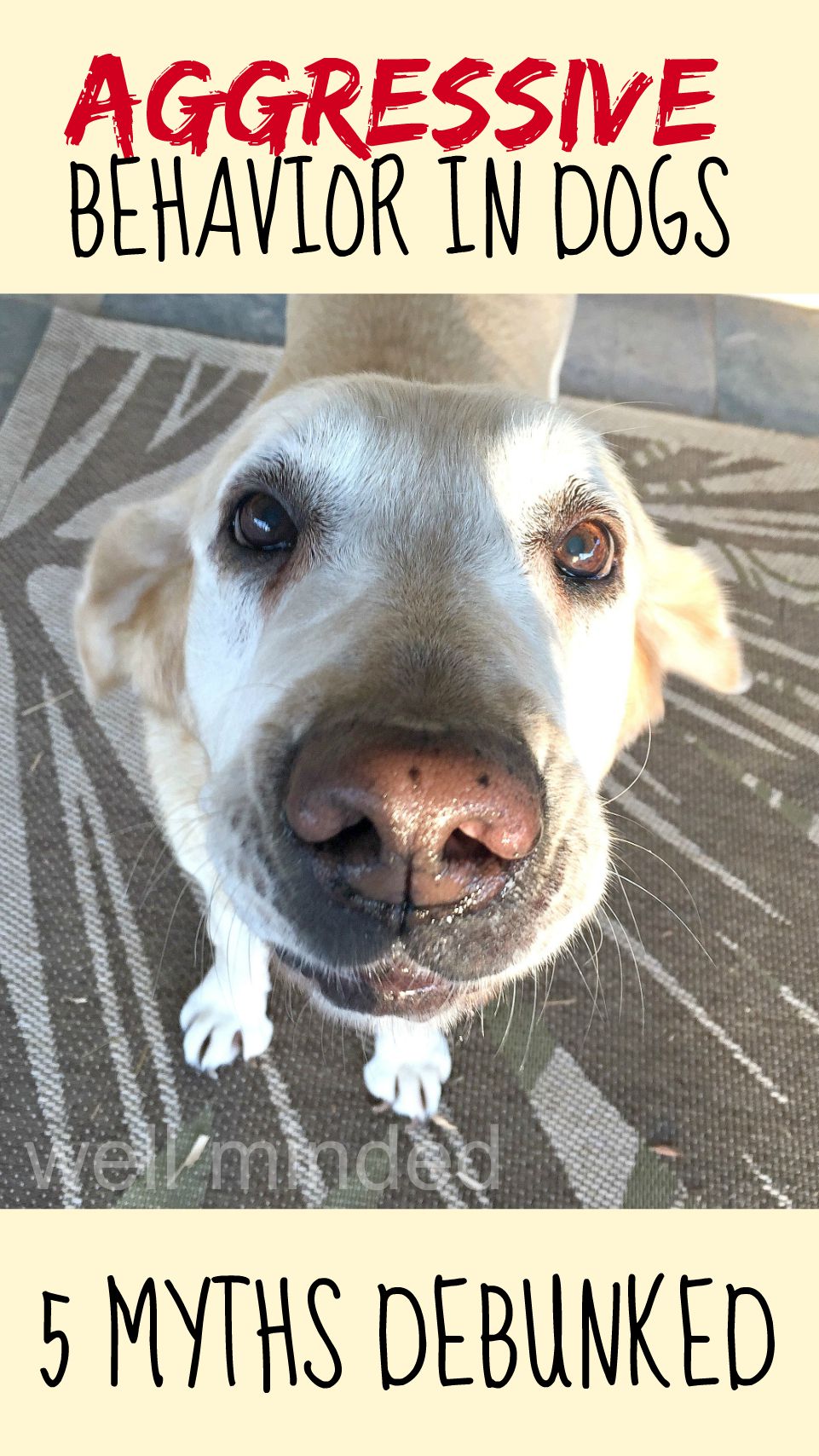What picture comes to mind when you think of an aggressive dog?
Don't think. Just close your eyes and picture that dog.
No, really. Do it now. I'll wait.
I'm going to guess that the majority of you pictured a medium-to large dog, either a pit bull breed or a long-muzzled breed, and one with a dark coat. The teeth are bared, the ears are back and the brow is furled. It's stance is strong and imposing, and it is either growling or barking.
How close did I get? I'll bet I predicted several of the features you pictured.
We all have biases and judgements when it comes to aggressive dogs. They may be based on personal experiences, what we've heard, or even what we've seen in the movies. This past week, I've been attending the Prosperous Pet Business Online Conference hosted by Kristin Morrison, founder of Six Figure Pet Sitting Academy. Kristin has interviewed some incredibly knowledgeable and fascinating leaders from all aspects of the pet industry, and one of my favorites, world-renowed dog trainer and behaviorist Victoria Stilwell, spoke about dog behavior and communication. She provided quite a great deal of insight about aggressive behavior in dogs. Some of what she said reinforced what I've learned in the past or have experienced, myself, and some of it was new to me. I'm incredibly thankful to gain this knowledge that I'd like to share with you. Based on my training and Victoria Stilwell's insights, I've compiled a list of five myths about aggressive behavior in dogs.
Aggressive Behavior in Dogs: 5 Myths Debunked.
This article is intended for informational purposes only. ALWAYS CONSULT A PROFESSIONAL TRAINER WHEN DEALING WITH AN AGGRESSIVE DOG.
5 myths about aggressive behavior in dogs
1. Dogs are aggressive because they want to be the alpha.
Victoria pointed out that being aggressive to become the alpha or boss is a very human way of thinking. Dogs think differently than we do, and it's sad that this is an accepted theory about why dogs become aggressive, as it promotes confrontational relationships between humans and dogs. Victoria said we should "throw the dominance myth into the trash can and leave it where it belongs." Dogs can show signs of dominance and assert them over each other and humans, but thinking these behaviors are aggressive is a flawed way of thinking.
So if not to be "top dog," why are dogs aggressive?
Dogs can be aggressive for about as many reasons as there are dogs, but some common reasons are medical issues, being uncomfortable or in pain, lack of confidence, or past traumatic experience.
2. Physical signs of aggression in dogs are obvious.
Remember that snarling dog you pictured earlier? Well, you hit the nail on the head, but you barely scratched the surface. That Kujo-like pooch you saw in your mind definitely showed signs of aggression, but only the obvious ones. There are many subtle signs of aggression that the average person can't read. Unless you have experience or education with the trickier signs, you may not take them for what they mean, which can put you and the dog in danger. According to Victoria Stilwell, some subtle signs of aggression in dogs include:
• stillness
• a quick freeze
• body tension
• head turn
• eye turn
• lip lick
All of these are signs that the dog is uncomfortable and may become aggressive.
I wish I had learned more of these subtle signs earlier in my career. I recall a time when I was making a pet sitting visit to a "guest dog" of a client of mine. This client's dogs had always been delights, and they knew me well. She told me that her friend was going away with her for the weekend and that his dog would be at the house, too. "He's really friendly and gets along great with my dogs, so I don't think you'll have a problem," she said. I trusted her (I know she meant no harm), and went along with it. When I arrived for my visit, I could see that the new pooch was a bit uncomfortable with me, so I kept my distance. After some time had passed, I noticed that he had been still in the corner of the room for quite some time, frozen, yet keeping his eyes on me. I stayed about twelve feet back, bent down, and extended my open palm, slightly, resting it on the floor.
The dog suddenly became the Tasmanian Devil, gnashing and barking, attacking my hand faster than I could pull it away. He did some serious damage, and I was in shock, both emotionally and physically. Had I known more about the subtle signs of aggression, perhaps I would have handled the situation differently.
Unfortunately, I didn't read the signals correctly, and this was the result.
3. Aggressive dogs are mean.
Victoria shared with us that "every dog has a degree of intelligence." Some have more intelligence than others (just like their human counterparts), but they all have some level of ability to process and reason, read intentions, or even imagine a solution to a problem. We often hear that dogs have the intelligence of a two-year-old. Victoria says that that is generally true, in terms of the human way of thinking, but that dogs have many abilities that take them beyond human abilities.
Aggressive dogs are rarely mean at heart, but are more likely suffering from a physical ailment or emotional trauma. If we can understand why they are bothered, we can work on the aggression issue. Victoria reminded us that dogs have the ability to love and the desire to love as humans do. They share those feelings and want to love and love back.
As a simple example, what happens to your behavior when you have a bad headache?
I know that when I have a headache, I'm much more irritable. I have the wherewithal to let my children know "Mommy doesn't feel well right now. Could we please keep the noise down?" If they don't, and I have to ask repeatedly, giving them signs and signals, I eventually snap. "QUIET! I HAVE A HEADACHE!" Since a dog doesn't have the spoken language advantage, his way of lashing out might be physical. It's not about being mean, it's about communicating a feeling. We all lash out, right or wrong. We need to understand that an aggressive dog isn't mean, but it trying to communicate a feeling.
4. We should punish aggressive behavior in dogs.
Since aggressive dogs often have dominance, fear, or insecurity issues, punishing the behavior can make it worse. It only reinforces that they should be fearful and plays upon their insecurities. We want to build these types of dogs up rather than beat them down. Victoria calls punishing aggressive behavior in dogs "unskilled handling."
So how can we help?
Victoria recommends aggressive dogs go through a process of habituation. Habituation is "gradually exposing the dog to something that it fears at a distance it can cope with, pairing it with something truly wonderful." Gradually, the distance is decreased as the dog learns to cope with the situation better through positive reinforcement.
This completely makes sense to me. Why punish aggressive behavior with aggressive or other negative behavior? Build the dog's confidence and watch him learn, change, and shine.
5. An aggressive dog can't be rehabilitated.
Though there are some very extreme cases where an aggressive dog can not be rehabilitated, Victoria says that it is extremely rare (she's seen it only about five times in twenty years of dog training). It depends on the history of the individual dog. Breed doesn't matter. It's always best to give a dog a chance with a professional trainer before deeming it unable to be rehabilitated.
looking beyond the snarl
I feel privileged to have had the opportunity to expand my knowledge about aggressive behavior in dogs with Victoria Stilwell through the Prosperous Pet Business Online Conference. My horizons were broadened, and I feel like I have a better understanding of the intricacies that surround these often misunderstood behaviors. Dog behavior is not always as it seems. As Victoria put it, "In order to be a good trainer, you always need to be learning. Dogs are highly evolved. Let's evolve with them."
English-born Victoria Stilwell is one of the world's most well-known and respected dog trainers. She is the star of Animal Planet's hit TV Series It's Me or the Dog. She has co-founded several successful dog training companies, and has authored best-selling dog training books. Check out her official web site for more information. Her site is filled with valuable information and resources.




